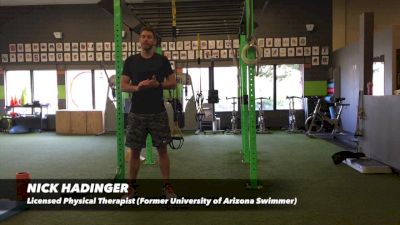SwiMobility #4: Lower Extremity Mobility

Dr. Nick Hadinger PT, DPT is a licensed physical therapist in the Portland, Oregon area working out of Therapeutic Associates -- Lake Oswego Physical Therapy. He swam collegiately for The University of Arizona from 2008-2012 where he received his BS in Physiology and earned his degree as a Doctor of Physical Therapy from Northern Arizona University.
Lower extremity injuries are not super common with swimmers, but they do happen. Most that I have seen have been related to overuse of hip flexors and a lack of hip extension range of motion. Swimming causes repetitive use of the hip flexor group and can lead to hip flexor strains, especially in breaststrokers due to the forced hip flexion through a greater range of motion. Hip flexor tightness can not only have an impact at the hip but also at the knee due to the IT band’s attachment to the tensor fasciae latae (TFL). The IT band itself cannot be stretched but by keeping muscles it attaches to loose and working tissue mobility in surrounding areas we can indirectly decrease tension in the IT band.
Hip internal rotation range of motion is also a big component (again, for breaststrokers in particular) as this range dictates how wide of a kick the swimmer can achieve. In this video the hip is stretched and mobilized in a position of hip extension and internal rotation as opposed to hip flexion and internal rotation as in the breaststroke kick to improve hip flexor mobility and hip extension range of motion and applies more to all strokes. Stretching into internal rotation with hip flexion (i.e. sitting back toward your heels) may correlate a bit better for breaststroke.
Another area of focus, more from the performance standpoint, is ankle plantar-flexion or how far you can point your toes down while you’re kicking. Improving plantar-flexion range of motion is huge for being able to move water on both sides of your kick. These soft tissue techniques can help to facilitate gains in this range of motion and improve the athlete’s ability to catch water with their feet. However, please be aware that the ideal ranges of plantar-flexion for swimming can lead to ankle instability which can be risk factors for injury during activities other than swimming (i.e. running and jumping). Working on ankle stability drills in conjunction with these techniques will help to avoid other injuries while continuing to progress your kicking speed.